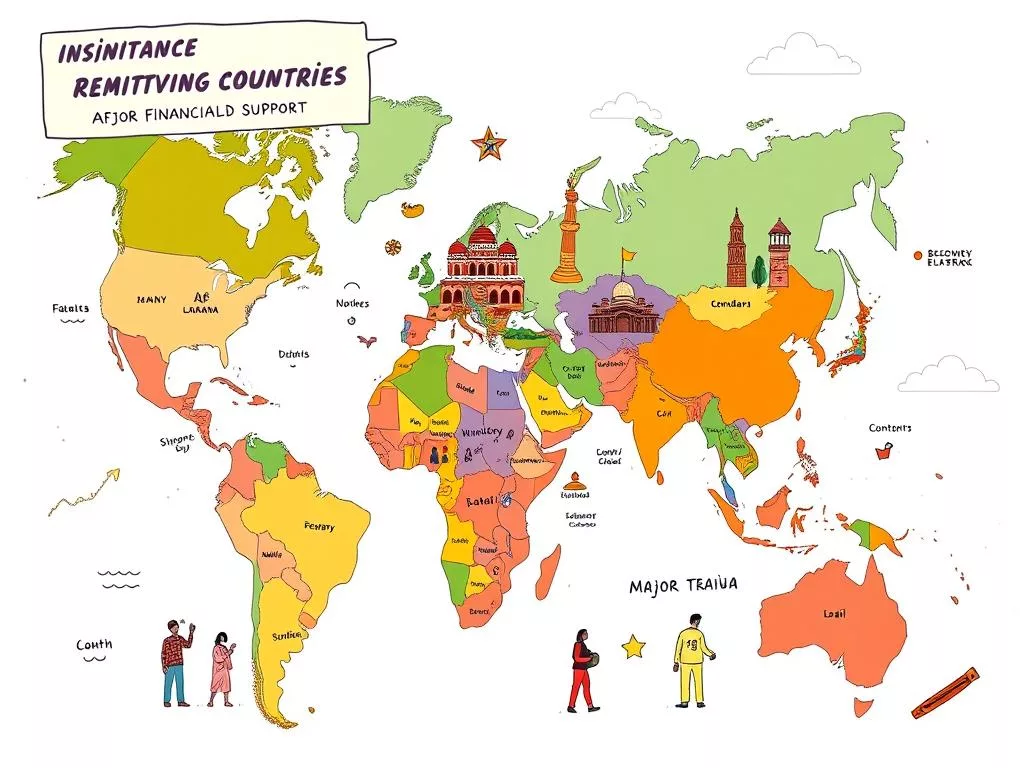In today’s world, remittances are key to global economic stability. They are mainly sent by migrant workers to their families back home. These funds are not just a lifeline for millions but also boost the economies of their countries.
In developing nations, remittances are a big deal. They often make up a large part of the GDP. This shows how important they are for these countries’ growth.
The Liberalised Remittance Scheme (LRS) in India shows how remittances are growing. In 2022-23, Indians sent $24.6 billion abroad. This is almost double what they sent the year before.
This increase highlights the role of remittances. It also shows the need for good money transfer services.
It’s important to understand remittance trends and follow good advice. This helps both individuals and businesses deal with international money transfers. By looking at where remittances matter most, we can see their impact. We can also find ways to make these money flows work better.
Introduction to Remittances and Their Importance
Remittances are the money people send back to their home countries. They help families and boost the economy, mainly in developing areas. In 2023, remittances hit $656 billion, which is as much as Belgium’s GDP.
The Reserve Bank of India’s Liberalised Remittance Scheme, started in 2004, makes sending money abroad easier. It helps with education, medical needs, and investments. This has greatly increased the flow of money from India, a top sender of remittances.
Now, digital platforms and online services are replacing old ways of sending money. This makes sending money faster and cheaper. The World Bank works to lower remittance costs by promoting transparency and competition.
In 2023, 184 million migrants sent money to their families. Half of them live in high-income countries. Remittances are vital for small and fragile states, making up 3% or more of their GDP.
Remittances are becoming more digital, using cryptocurrencies to cut costs and speed up transactions. This is good for migrants from developing countries. The World Bank also helps by analyzing remittance prices and removing barriers.
Understanding remittances is key to grasping the global financial scene. They are more important than Foreign Direct Investment and Official Development Assistance for developing countries. Efforts to make remittances more efficient and affordable are ongoing.
Repatriation of funds is an area of constant improvement. It promises better ways to manage these critical financial exchanges.
| Year | Remittances ($ Billion) | Global Migrants (Million) |
|---|---|---|
| 2023 | 656 | 184 |
| 2024 (Projected) | 690 | 192 |
Major Destinations Where Remittances Matter Most
India leads the list of major remittance receiving countries, with $24.6 billion in remittances in 2022-23. These funds are key to the economy, boosting spending and investments. Countries like China, the Philippines, Pakistan, Bangladesh, and Uzbekistan also rely heavily on migrant money.
In the Asia-Pacific, countries like Tajikistan, Tonga, Samoa, and Nepal depend a lot on remittances. These funds make up a big part of their GDP. This shows the importance of good remittance channels and affordable transactions.

Women migrants make up about 50% of all migrants, sending smaller but more frequent amounts. This leads to higher costs. Yet, the economic benefits are huge. For example, in 2021, Pakistan got $31.1 billion in remittances, a 19.8% increase from the year before. These funds were about 10% of Pakistan’s GDP, showing their big impact.
The Asia-Pacific region also benefits from cheaper remittance paths. For instance, transfers from the Russian Federation and Gulf Cooperation Council countries are less expensive. Malaysia and several Central Asian countries also offer low-cost options. But, countries like Thailand face higher fees, mainly due to transfer costs.
Looking at remittances from key sources outside Asia and the Pacific, like Saudi Arabia and the United Arab Emirates, gives more insights. Digital remittance services are growing, but costs haven’t dropped much. This is partly because many undocumented workers use informal services.
| Country | Remittance Inflows (USD Billion) | % of GDP |
|---|---|---|
| India | 24.6 | — |
| Pakistan | 31.1 | 10% |
| Tajikistan | — | 20–30% |
| Tonga | — | 20–30% |
Understanding remittance data by country shows the big economic impact on these top destinations. By looking at the factors and their effects, we see how these funds are a strong economic support, helping with stability and growth.
Guide to Where Remittances Matter Most: Detailed Insight
Remittances play a big role in helping countries grow. They improve healthcare, education, and the economy. This shows how important they are for the betterment of these areas.

The Liberalised Remittance Scheme lets people send money up to a certain amount each year. It’s flexible and allows for many types of transactions. This makes it a key way to send money from India.
Remittances do more than just send money. They help in many ways:
- Healthcare: They help people get better medical care.
- Education: They pay for school fees and materials, improving education.
- Economic Investments: They support small businesses and real estate, boosting the economy.
Many people send remittances, like migrant workers and students. They use different ways to send money, like bank transfers and mobile payments. Some choose less common methods like postal orders or ACH transfers.
The shift from checks to digital payments shows a move towards modern ways. Digital payments make sending money more accurate and efficient. This highlights the need for good advice on remittances.
By understanding how remittances work, we see their value. They are essential for millions, supported by strong systems and new technologies. These ensure money is sent on time and makes a real difference.
How to Send Remittances Efficiently
Sending money abroad can be made easier by using efficient remittance methods. Start by comparing traditional banks with digital platforms like Wise and Currencies Direct. Digital platforms offer low-cost money transfer services with lower fees and better exchange rates. They also transfer money faster.
These platforms save businesses a lot of time by automating remittances. They can be up to 90% accurate in applying cash.
International transfer tips include checking recipient details and watching exchange rates. Traditional bank transfers might cost more due to higher fees and less favorable rates. But, companies like Wise offer clear fees and fast transactions, helping with cash flow.
For businesses sending lots of payments, EDI-based remittance advice is a good choice. It’s used by big names like Amazon and Walmart.
Choosing the right provider and method is key. Costs depend on the amount, exchange rates, and method. Knowing all fees and following rules protects everyone involved. Tech advancements help small businesses manage remittances better, avoiding common issues like errors.
For more tips on improving remittance reporting and analysis, check out this resource.

